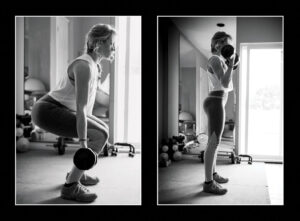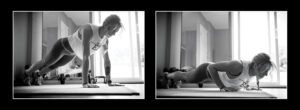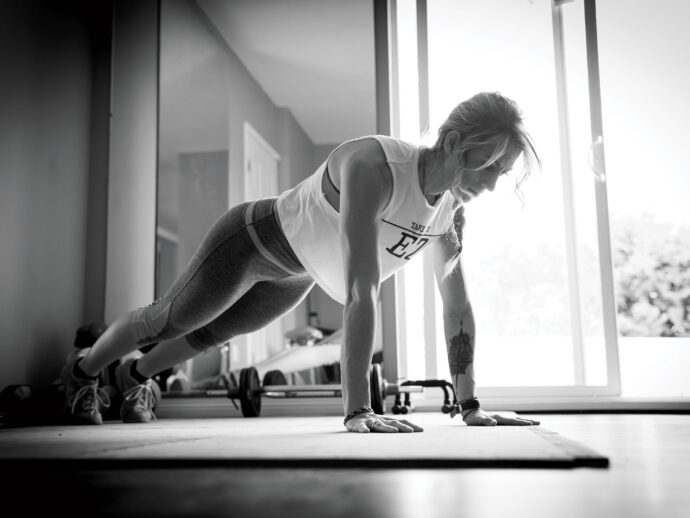
Brains and exercise are a great combination. By exercising regularly we increase blood flow and improve the generation of new neurons in the area of our brain responsible for long-term memory. Read on to find out which exercises increase brain health.
Alzheimer’s disease and other forms of dementia are on the rise in Canada. According to the Harvard Health Blog, there is a new case of dementia detected every four seconds around the globe. You probably know at least one person who has been affected.
Working on preventing brain disease can start at any age, and luckily, you can even get benefits when you’re in your senior years. Putting consistent time and energy into exercising regularly is a great preventive measure for Alzheimer’s and other forms of dementia. A 2009 study in the journal Gerontology suggests that regular exercise across the lifespan can help with cognitive function.
UBC professor Teresa Liu-Ambrose says, “Weight training, even as little as once or twice a week, can minimize the rate of decline and change the disease course.” In a 2012 study conducted at UBC, Liu-Ambrose found that female participants showing signs of early dementia who engaged in weight training showed “significant improvements in both memory and executive functions.” She also saw more neural activity in the brain following weight training.
Aerobic exercise is also important, as it stimulates neurogenesis (the birth of new neurons) in the brain. The hippocampus, an area in our brains responsible for long-term memory, showed increased neurogenesis following a seven-week regimen of sustained aerobic activity, according to a recent study in the Journal of Physiology.
While reversing dementia, Alzheimer’s, or other cognitive diseases would be wonderful, it’s not possible at this time. However, says James Jackson, a neuropsychologist and expert in issues related to brain health at the Vanderbilt University School of Medicine, “Regular exercise has been shown to slow down dementia progression.
“This is important because, although we don’t currently have the ability to reverse the process of dementia once it starts, every day the dementia progression is slowed or delayed is a really precious day to dementia sufferers and their friends and families.”
Jackson also agrees that “exercise has many clinically meaningful benefits for cognitive functioning and that it decreases the risk of developing many chronic diseases that are themselves associated with dementia.”
The following seven exercises are designed to help with brain health and cognition. These exercises should be done in a circuit, including both aerobic and strength-training exercises to enhance the birth of more brain neurons.
Each exercise is 30 seconds long, followed by a 10-second rest. Go through the circuit, then repeat up to three times, three times per week.
Community benefits
If you’re unsure about exercising on your own, or want help for friends or family with dementia or Alzheimer’s, check out your local community centre for programming options. They may have group classes or personal training available.
Start small
If you can’t get through the whole workout today, just do what you can. Each time you do the exercises you will get stronger and gain more endurance. Stick with it!
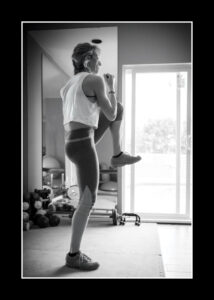
Standing Knee Raises
Muscles targeted: cardiovascular (heart), thighs, and abdominals
- Stand with feet hip-width apart
- Bring one knee up, and pull both of your elbows toward your knee at the same time, like a standing crunch.
- Release that knee, then quickly bring up the other knee.
Increase the intensity: Bounce as you lift your knees.
Squats with Bicep Curls
Muscles targeted: gluteals, thighs, and biceps
- Stand with your feet hip-width apart, or slightly wider.
- Hold dumbbells in your hands by your sides, and sit back into a squat position, with your knees behind your toes and your chest lifted up.
- Keep your core engaged, and as you stand up, curl your arms and squeeze your biceps.
Increase the intensity: Add a shoulder press at the top.
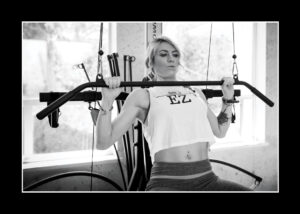
Lat Pull-Downs
Muscles targeted: latissimus dorsi, biceps, and core
- Sit at a lat pull machine and place your hands about shoulder-width apart on the bar.
- Pull the bar down toward your sternum, keeping your core engaged.
- Release the bar back up slowly.
Increase the intensity: Place your hands wider on the bar.
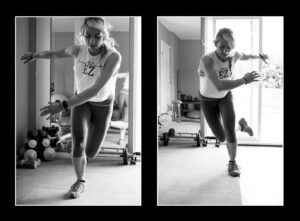
Side-to-Side Bounding
Muscles targeted: cardiovascular (heart) and thighs
- Stand with your feet together, then hop to one side, leading with one leg.
- Hop immediately to the other side, like you’re jumping over a small barrier, making sure to swing your arms side to side as you are bounding.
- If you don’t want to hop, take large steps from side to side.
Increase the intensity: Bound faster.
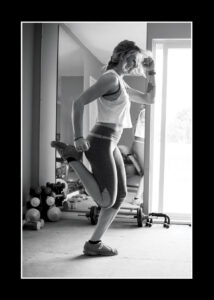
Standing Heel Kicks with Forward Reach
Muscles targeted: cardiovascular (heart), hamstrings, and shoulders
- Stand with your feet hip-width apart, arms by your sides.
- Alternating legs, kick your feet back toward your bum.
- As you kick, reach both arms forward and back.
Increase the intensity: Do running heel kicks.
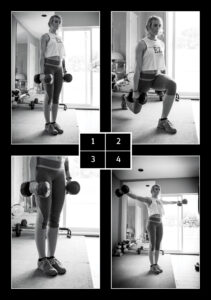
Rear Lunges with Lateral Shoulder Raises
Muscles targeted: thighs, gluteals, and shoulders
- Stand with both feet together and arms by your sides, holding light dumbbells.
- Step one leg back, and drop your knee toward the floor, lifting your rear heel off the ground. Your front knee should be at 90 degrees.
- As you come back to standing, raise your arms to your sides with a slight bend in your elbows.
- Repeat on the other leg.
Increase the intensity: Drop your knee closer to the floor.
Chest Press Machine or Push-Ups
Muscles targeted: pectorals (chest), biceps, and core
- Sit at a chest press machine; your shoulders should be in line with the handles.
- Push your arms forward slowly, making sure not to lock your elbows.
- Keep your core tight.
- Release back slowly and repeat.
Increase the intensity: Do push-ups on the floor.
Exercise is fun with friends!
Hitting the gym on your own is great, but if you want to keep it social, why not try taking an exercise class with people you relate to? Local community centres/seniors’ centres have many offerings for group fitness, tai chi, fencing, and more.
If that’s not your thing, what about trying out a new sport or club where you can be active with other people? People who are active in a group setting get the benefits of both social bonding and enhanced exercise ability.
If you’re unsure where to start when it comes to improving your brain health, begin with your body. Getting active and moving on a regular basis stimulates your body and mind, increases blood flow and oxygen to the brain, and helps decrease the risk of many diseases.
It’s never too late to start an exercise program, and with this easy-to-follow home or gym workout plan, you can get fit and help decrease the risk or rate of diseases such as dementia and Alzheimer’s.





